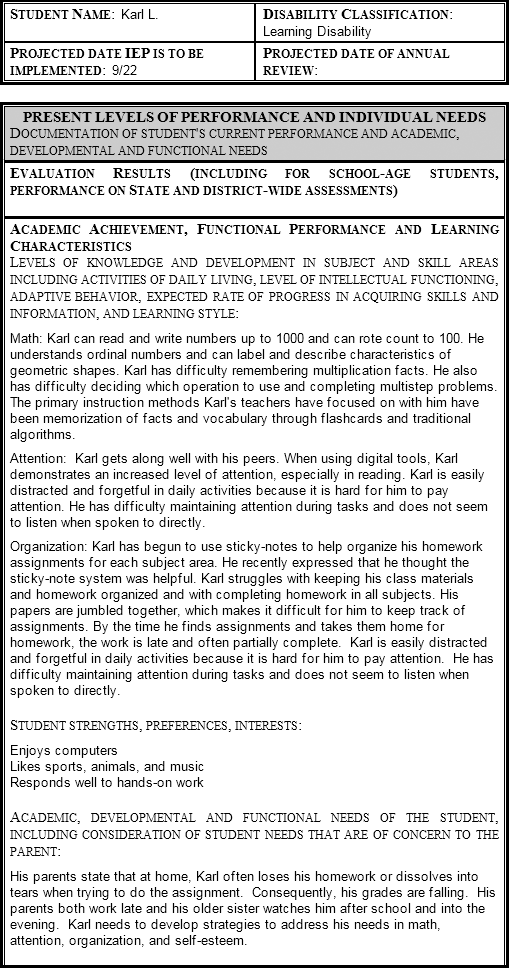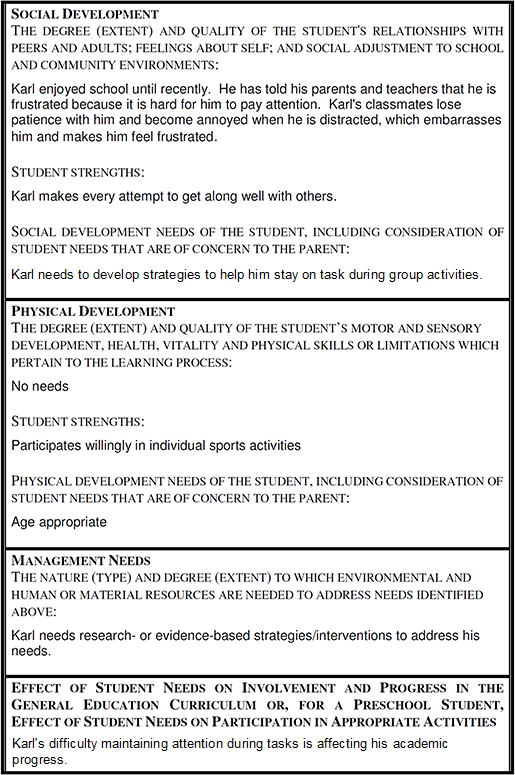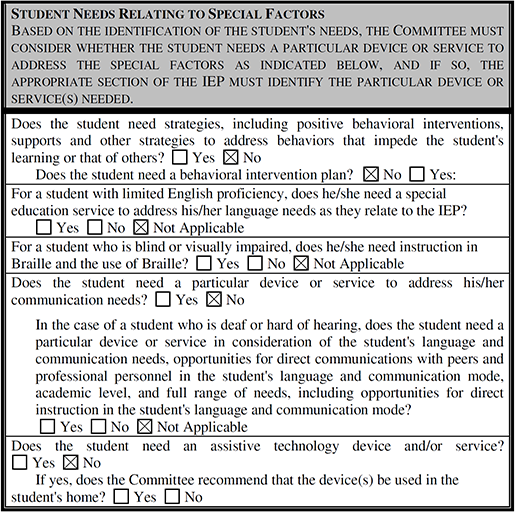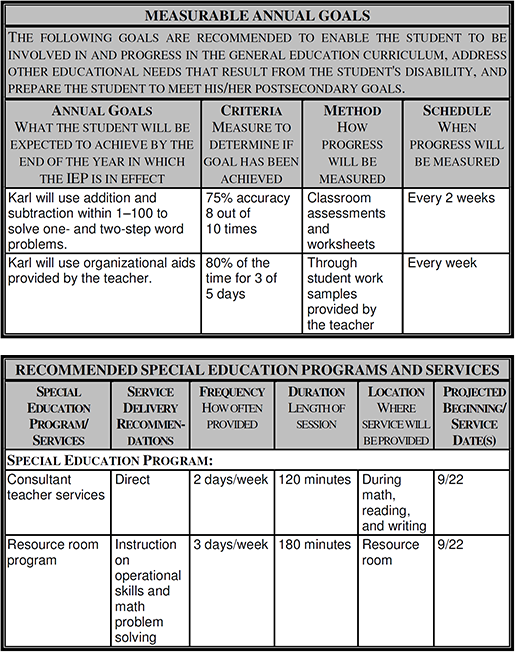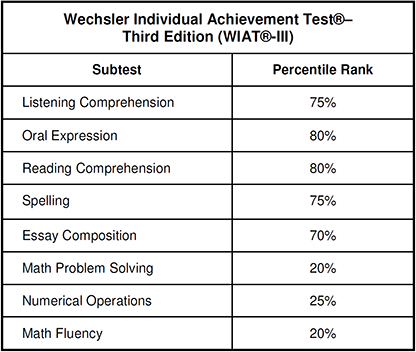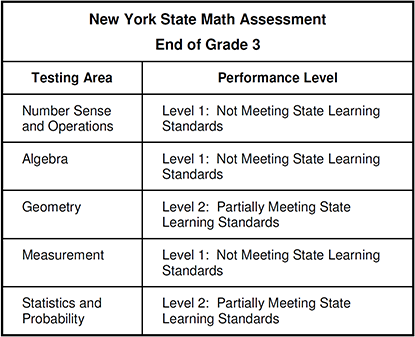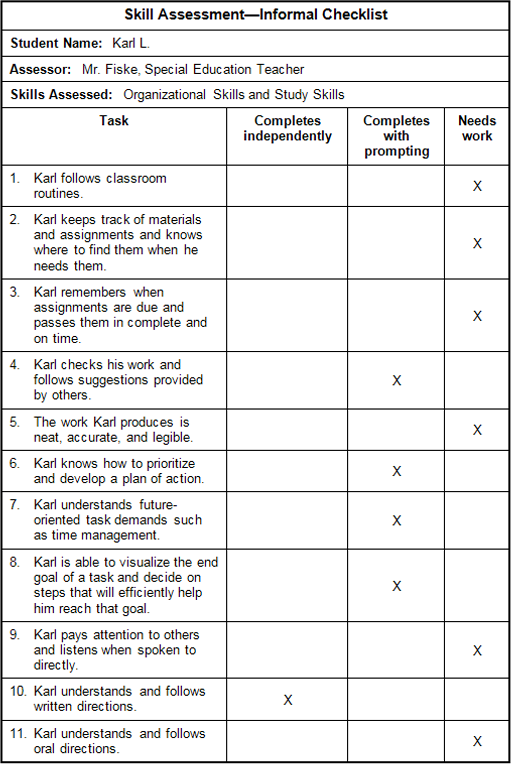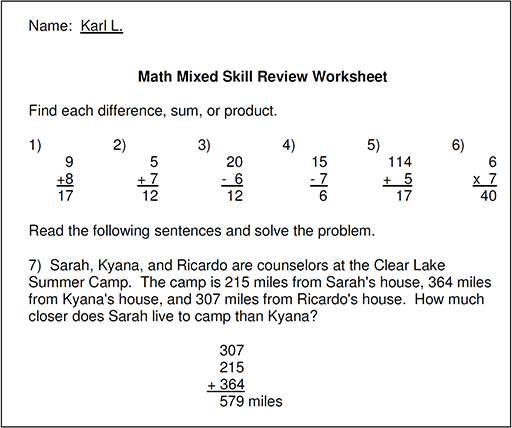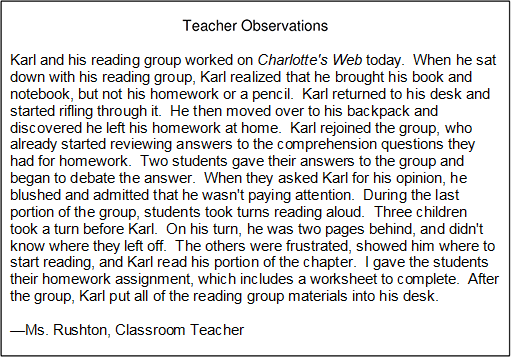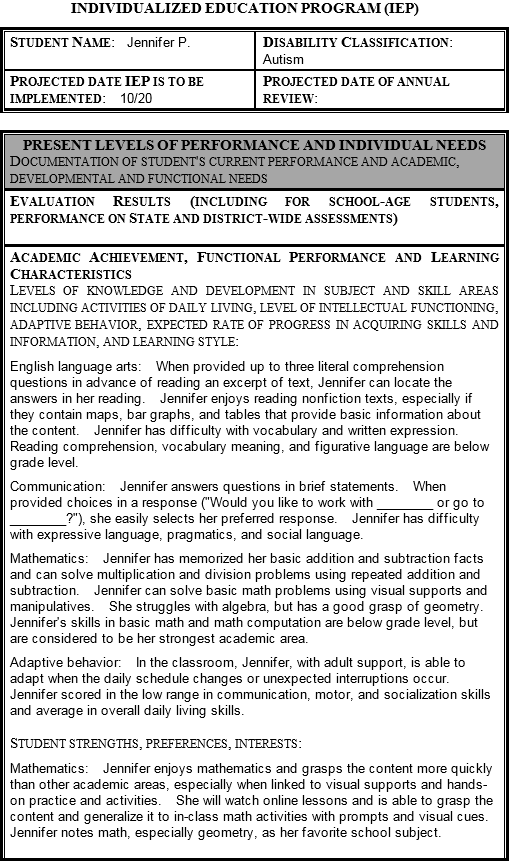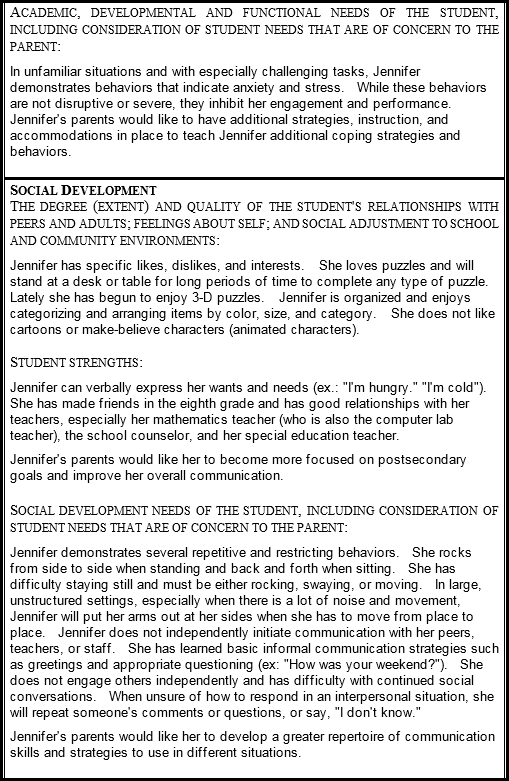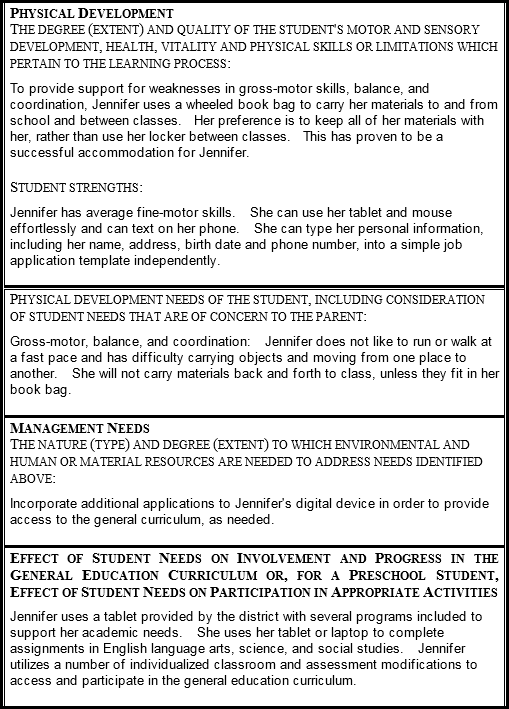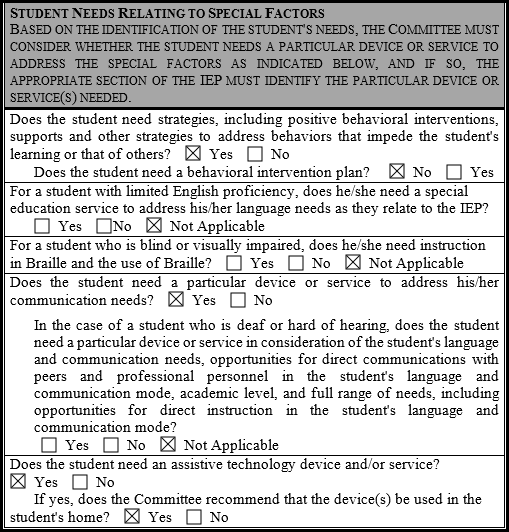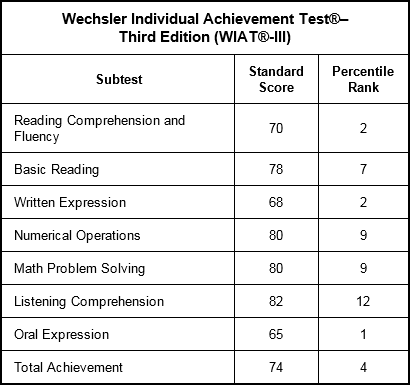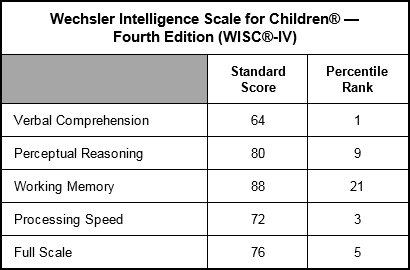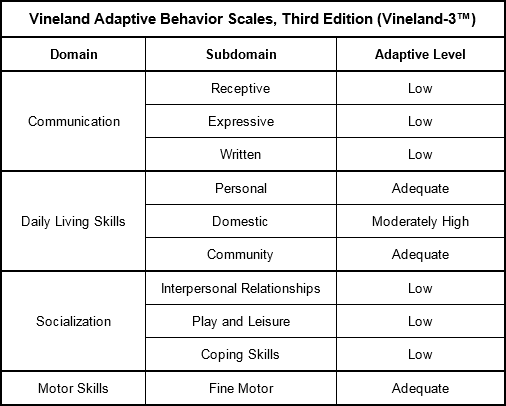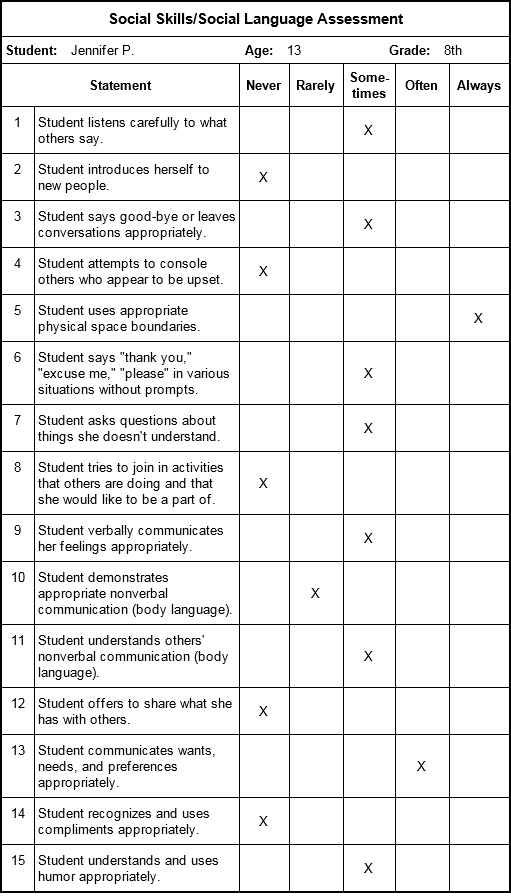Study Guide
Field 060: Students with Disabilities
Recommendation for individuals using a screenreader: please set your punctuation settings to "most."
Sample Constructed-Response Item 1
Competency 0007
Analysis, Synthesis, and Application
Use the information provided in the exhibits to complete the task that follows.
Analyze the information provided in the exhibits, using evidence from all of the exhibits to support your ideas, and write a response of approximately 400 to 600 words in which you:
- describe one area of need Karl has that is related to academics, and one area of need that he has that is related to study skills;
- recommend one research-based or evidence-based strategy/intervention that you would use to address the academic need that you have described, and explain why this strategy/intervention would be appropriate; and
- recommend one research-based or evidence-based strategy/intervention that you would use to address the study skills need that you have described, and explain why this strategy/intervention would be appropriate.
Be sure to use evidence from all exhibits in your response.
Exhibit 1: Student Profile
Karl is a nine-year-old fourth-grade student who has recently been classified with a learning disability in math reasoning and calculation and diagnosed with attention deficit hyperactivity disorder ( A D H D ). He attends a general education fourth-grade class for most of the day. He will be receiving special education services for mathematics in the resource room with Mr. Fiske. He also will be receiving consultant teacher ( C T ) services in his classroom to address organizational skills.
The Committee on Special Education ( C S E ) recently met to review and discuss the results of Karl's initial evaluation, progress monitoring from Response to Intervention (RtI) (see Exhibit 2: " I E P Excerpt and Initial Evaluation"), a student work sample, and teacher observations (see Exhibit 3: "Work Sample and Teacher Observations").
During the meeting, the committee members discussed Karl's academic history, present levels of performance, and current behavioral issues. At the end of second grade, Karl's teacher noticed his difficulty in operation skills and math problem-solving skills. In third grade, Karl received Tier 2 and Tier 3 RtI interventions, but did not make adequate progress in most areas. Karl was then referred to the C S E and he was determined to be eligible for special education services. He was classified with a learning disability in math, and he was referred for additional services (see Exhibit 2: " I E P Excerpt and Initial Evaluation").
Exhibit 2: IEP Excerpt and Initial Evaluation
Student name: Karl L.
Disability classification: learning disability.
Projected date I E P is to be implemented: September seventh.
Projected date of annual review: blank.
Present levels of performance and individual needs. Documentation of student?s current performance and academic, developmental, and functional needs.
Evaluation results (including for school-age students, performance on state and district-wide assessments).
Academic achievement, functional performance and learning characteristics. Levels of knowledge and development in subject and skill areas including activities of daily living, level of intellectual functioning, adaptive behavior, expected rate of progress in acquiring skills and information, and learning style:
Math: Karl can read and write numbers up to 1000 and can rote count to 100. He understands ordinal numbers and can identify and describe characteristics of geometric shapes. Karl has difficulty remembering multiplication facts. He also has difficulty deciding which operation to use and completing multistep problems. The primary instruction methods Karl's teachers have focused on with him have been memorization of facts and vocabulary through flashcards and traditional algorithms.
Attention: Karl gets along well with his peers. When using digital tools, Karl demonstrates an increased level of attention, especially in reading. Karl is easily distracted and forgetful in daily activities because it is hard for him to pay attention. He has difficulty maintaining attention during tasks and does not seem to listen when spoken to directly.
Organization: Karl has begun to use sticky-notes to help organize his homework assignments for each subject area. He recently expressed that he thought the sticky-note system was helpful. Karl struggles with keeping his class materials and homework organized and with completing homework in all subjects. His papers are jumbled together, which makes it difficult for him to keep track of assignments. By the time he finds assignments and takes them home for homework, the work is late and often partially complete. Karl is easily distracted and forgetful in daily activities because it is hard for him to pay attention. He has difficulty maintaining attention during tasks and does not seem to listen when spoken to directly.
Student strengths, preferences, interests: Enjoys computers. Likes sports, animals, and music. Responds well to hands-on work.
Academic, developmental and functional needs of the student, including consideration of student needs that are of concern to the parent: His parents state that at home, Karl often loses his homework or dissolves into tears when trying to do the assignment. Consequently, his grades are falling. His parents both work late and his older sister watches him after school and into the evening. Karl needs to develop strategies to address his needs in math, attention, organization, and self-esteem.
Social development. The degree (extent) and quality of the student?s relationships with peers and adults; feelings about self; and social adjustment to school and community environments: Karl enjoyed school until recently. He has told his parents and teachers that he is frustrated because it is hard for him to pay attention. Karl?s classmates lose patience with him and become annoyed when he is distracted, which embarrasses him and makes him feel frustrated.
Student strengths: Karl makes every attempt to get along well with others.
Social development needs of the student, including consideration of student needs that are of concern to the parent: Karl needs to develop strategies to help him stay on task during group activities.
Physical development: The degree (extent) and quality of the student?s motor and sensory development, health, vitality and physical skills or limitations which pertain to the learning process: No needs.
Student strengths: Participates willingly in individual sports activities.
Physical development needs of the student, including consideration of student needs that are of concern to the parent: Age appropriate.
Management needs: The nature (type) and degree (extent) to which environmental and human or material resources are needed to address needs identified above: Karl needs research- or evidence-based strategies/interventions to address his needs.
Effect of student needs on involvement and progress in the general education curriculum or, for a preschool student, effect of student needs on participation in appropriate activities: Karl?s difficulty maintaining attention during tasks is affecting his academic progress.
Student needs relating to special factors: Based on the identification of the student?s needs, the committee must consider whether the student needs a particular device or service to address the special factors as indicated below, and if so, the appropriate section of the I E P must identify the particular device or services needed. Does the student need strategies, including positive behavioral interventions, supports, and other strategies to address behaviors that impede the student?s learning or that of others? No. Does the student need a behavioral intervention plan? No. For a student with limited English proficiency, does he/she need a special education service to address his/her language needs as they relate to the IEP? Not applicable For a student who is blind or visually impaired, does he or she need instruction in Braille and the use of Braille? Not applicable. Does the student need a particular device or service to address his or her communication needs? No. In the case of a student who is deaf or hard of hearing, does the student need a particular device or service in consideration of the student?s language and communication needs, opportunities for direct communications with peers and professional personnel in the student?s language and communication mode, academic level, and the full range of needs, including opportunities for direct instruction in the student?s language and communication mode? Not applicable. Does the student need an assistive technology and or service? No. If yes, does the committee recommend that the devices be used in the student?s home? Blank.
Measurable annual goals. The following goals are recommended to enable the student to be involved in and progress in the general education curriculum, address other education needs that result from the student?s disability, and prepare the student to meet his or her postsecondary goals. Annual goals: what the student will be expected to achieve by the end of the year in which the I E P is in effect. First annual goal. Karl will use addition and subtraction within one to hundred to solve one- and two-step word problems. Criteria: measure to determine if goal has been achieved. Criteria for first goal. 75 percent accuracy 8 out of 10 times. Method: how progress will be measured. Method for first goal. Classroom assessments and worksheets. Schedule: When progress will be measured. Schedule for first goal: every 2 weeks. Second annual goal: Karl will use organizational aids provided by the teacher. Criteria for second goal. 80 percent of the time for 3 of 5 days. Method for second goal. Through student work samples provided by the teacher. Schedule for second goal: every week. Recommended special education programs and services. Two items listed. First special education program or services: consultant teacher services. First service delivery recommendations: direct. First frequency (how often provided): two days a week. First duration (length of session): one hundred and twenty minutes. First location (where service will be provided): During math, reading, and writing. First projected beginning or service dates: September twenty second. Second special education program or services: resource room program. Second service delivery recommendations: instruction on operational skills and math problem solving. Second frequency: three days a week. Second duration: one hundred and eighty minutes. Second location: Resource room. Second projected beginning or service dates: September twenty second.
Wechsler Individual Achievement Test Third Edition (W I A T Three). Subtest: Listening comprehension. Percentile Rank: 75 percent. Subtest: Oral expression. Percentile Rank: 80 percent. Subtest: Reading comprehension. Percentile Rank: 80 percent. Subtest: Spelling. Percentile Rank: 75 percent. Subtest: Essay composition. Percentile Rank: 70 percent. Subtest: Math problem solving. Percentile Rank: 20 percent . Subtest: Numerical operations. Percentile Rank: 25 percent. Subtest: Math fluency. Percentile Rank: 20 percent.
New York State Math Assessment. End of Grade 3. Testing area: Number sense and operations. Performance level: Level 1: Not meeting state learning standards. Testing area: Algebra. Performance level: Level 1: Not meeting state learning standards. Testing area: Geometry. Performance level: Level 2: Partially meeting state learning standards. Testing area: Measurement. Performance level: Level 1: Not meeting state learning standards. Testing area: Statistics and probability. Performance level: Level 2: Partially meeting state learning standards.
Skill assessment: informal checklist. Student name: Karl L. Assessor: Mr. Fiske, Special Education Teacher. Skills Assessed: Organizational Skills and Study Skills. First task: Karl follows classroom routines. Needs work. Second task: Karl keeps track of materials and assignments and knows where to find them when he needs them. Needs work. Third task: Karl remembers when assignments are due and passes them in complete and on time. Needs work. Fourth task: Karl checks his work and follows suggestions provided by others. Completes with prompting. Fifth task: The work Karl produces is neat, accurate, and legible. Needs work. Sixth task: Karl knows how to prioritize and develop a plan of action. Completes with prompting. Seventh task: Karl understands future oriented task demands, such as time management. Completes with prompting. Eighth task: Karl is able to visualize the end goal of a task and decide on steps that will efficiently help him reach that goal. Completes with prompting. Ninth task: Karl pays attention to others and listens when spoken to directly. Needs work. Tenth task: Karl understands and follows written directions. Completes independently. Eleventh task: Karl understands and follows oral directions. Needs work.
Exhibit 3: Work Sample and Teacher Observations
Name: Karl L. Math Mixed Skill Review Worksheet. Find each difference, sum, or product. Question one. 9 plus 8 equals 17. Question two. 5 plus 7 equals 12. Question three. 20 minus 6 equals 12. Question four. 15 minus 7 equals 6. Question five. 114 plus 5 equals 17. Question six. 6 times 7 equals 40. Read the following sentences and solve the problem. Question seven. Sarah, Kyana, and Ricardo are counselors at the Clear Lake Summer Camp. The camp is 215 miles from Sarah?s house, 364 miles from Kyana?s house, and 307 miles from Ricardo?s house. How much closer does Sarah live to camp than Kyana? 307 plus 215 plus 364 equals 579 miles.
Teacher observations. Karl and his reading group worked on Charlotte?s web today. When he sat down with his reading group, Karl realized that he brought his book and notebook, but not his homework or a pencil. Karl returned to his desk and started rifling through it. He then moved over to his backpack and discovered he left his homework at home. Karl rejoined the group, who already started reviewing answers to the comprehension questions they had for homework. Two students gave their answers to the group and began to debate the answer. When they asked Karl for his opinion, he blushed and admitted that he wasn?t paying attention. During the last portion of the group, students took turns reading aloud. Three children took a turn before Karl. On his turn, he was two pages behind, and didn?t know where they left off. The others were frustrated, showed him where to start reading, and Karl read his portion of the chapter. I gave the students their homework assignment, which includes a worksheet to complete. After the group, Karl put all of the reading group materials into his desk. Ms. Rushton, Classroom Teacher.
Sample Strong Response to Constructed-Response Item 1
Karl demonstrates academic weaknesses in math calculation and problem-solving which are most likely exacerbated by his A D H D . Based on the assessments and data provided, Karl's weaknesses in the auditory learning and memory domain are illustrated by behaviors, "does not seem to listen when spoken to directly," and observations that Karl "needs work" in the area of understanding and following oral directions. Even with Tier 2 and 3 interventions to address these needs, Karl continues to struggle with memory, problem-solving, retrieval of information for math facts and processes related to numeracy.
Academic strategies to address math numeracy and number sense should be tailored to Karl's kinesthetic and visual domains. To address the addition of 3-digit numbers, I would teach Karl how to break up numbers using place value as demonstrated with manipulatives and visual strategies. He needs to understand that the number 25, for example, can be visualized as 2 groups of ten and 5 ones, 1 group of 10 and 15 ones, and 25 ones. He can continue to break down 25 into arrays such as 5 groups of 5 (beginning multiplication). As Karl begins to demonstrate his ability to decompose numbers, he can learn to add, subtract, multiply and divide using manipulatives and mental math calculations.
This strategy would be appropriate for Karl because it is a visual-kinesthetic strategy; often an area of strength for students with A D H D . By fourth grade, fluency and flexibility with numbers and calculation is essential for competency. If Karl understands how numbers "work," he can begin to visualize processes which will aid with remembering facts, steps and procedures needed in more advanced calculations.
Karl's weakness in study skills and his poor organization, both probably related to his A D H D , are affecting his academic progress and motivation to complete tasks. This is described in Exhibit 2 under Present Levels of Performance which states "his papers are jumbled together, which makes it difficult for him to keep track of assignmentsÖ work is late and often partially complete." To address this, I would teach Karl a strategy for keeping his own homework checklist. I will create a template that Karl will use to record his homework daily, including a place to check what he needs, does he have it, did he do it. The template will be attached to a binder containing colored folders that correspond with different subjects (ex. ELA=blue, Math=yellow, etc.). Karl will organize his assignments in the colored folders. Initially, I would provide direct supervision. As he demonstrates progress towards this goal, I would reduce my support until Karl only requires monitoring. I will confer with Karl to see if he is finding this helpful and through this feedback make modifications as necessary. Each day his homework is completed, I will write an encouraging comment on his checklist.
This strategy is appropriate for Karl based on the relative strength noted in the Skill Assessment: shows independence in understanding and following written directions and, with support, is able to prioritize in order to develop a plan of action. Teaching organizational strategies to an independent level helps to develop study skills and in turn boost academic success. It will also help strengthen Karl's ability to study and can be applied across subject areas, which will aid him in completing and turning in homework. Research has shown that A D H D students respond well to structure and routine. This strategy would be a step forward for Karl to be more successful in school and hopefully to have fewer meltdowns at home over assignments.
Sample Constructed-Response Item 2
Competency 0007
Analysis, Synthesis, and Application
Use the information in the exhibits provided to complete the assignment that follows.
Analyze the information provided in the exhibits, using evidence from all the exhibits to support your ideas, and write a response of approximately 400 to 600 words in which you:
- describe one area of need Jennifer has that is related to academics and one area of need she has that is related to behavior;
- recommend one research-based or evidence-based strategy/intervention you would use to address the academic need you have described and explain why this strategy/intervention would be appropriate; and
- recommend one research-based or evidence-based strategy/intervention you would use to address the behavioral need you have described and explain why this strategy/intervention would be appropriate.
Be sure to use evidence from all exhibits in your response.
Exhibit 1: Student Profile
Jennifer is a 13-year-old eighth-grade student with autism. Jennifer attends general education classes and receives integrated co-teaching for science and social studies. Direct consultant teaching is provided by Ms. Santiago, the special education teacher for English language arts and mathematics instruction. Speech-language therapy is provided as a related service by the speech-language pathologist, Ms. Wilcox, to support Jennifer's continued progress in the general education setting.
Jennifer uses a digital device to follow her daily schedule, access digital books, learn and practice new vocabulary, and complete individualized assignments. She relies on a number of visual supports to support her access to the curriculum in all academic areas.
Jennifer participates in a bimonthly peer-to-peer mentoring program with a group of eighth-grade girls and high school student volunteers. This program is coordinated by Mr. Nolan, the school-based counselor, and focuses on developing life skills and promoting healthy living and positive social-emotional development. Jennifer has expressed that she enjoys this program. She has expressed that she thinks of the participants as "her best friends."
Jennifer's Committee on Special Education ( C S E ) recently met to discuss and analyze information and findings from Jennifer's three-year reevaluation (see exhibit titled " I E P Excerpt and Initial Evaluation").
During the meeting, committee members discussed Jennifer's academic strengths and needs. Jennifer's parents have asked for specific opportunities for Jennifer to develop career and employment-related skills, as well as assistive technology and accommodations that will support her greater independence in communication.
Exhibit 2: IEP Excerpt and Initial Evaluation
INDIVIDUALIZED EDUCATION PROGRAM (I E P)
Student name: Jennifer P.
Disability classification: Autism.
Projected date I E P is to be implemented: October 20.
Projected date of annual review: blank.
Present levels of performance and individual needs. Documentation of student?s current performance and academic, developmental, and functional needs.
Evaluation results (including for school-age students, performance on state and district-wide assessments).
Academic achievement, functional performance and learning characteristics. Levels of knowledge and development in subject and skill areas including activities of daily living, level of intellectual functioning, adaptive behavior, expected rate of progress in acquiring skills and information, and learning style:
English language arts: When provided up to three literal comprehension questions in advance of reading an excerpt of text, Jennifer can locate the answers in her reading. Jennifer enjoys reading nonfiction texts, especially if they contain maps, bar graphs, and tables that provide basic information about the content. Jennifer has difficulty with vocabulary and written expression. Reading comprehension, vocabulary meaning, and figurative language are below grade level.
Communication: Jennifer answers questions in brief statements. When provided choices in a response ("Would you like to work with blank line or go to blank line?"), she easily selects her preferred response. Jennifer has difficulty with expressive language, pragmatics, and social language.
Mathematics: Jennifer has memorized her basic addition and subtraction facts and can solve multiplication and division problems using repeated addition and subtraction. Jennifer can solve basic math problems using visual supports and manipulatives. She struggles with algebra, but has a good grasp of geometry. Jennifer's skills in basic math and math computation are below grade level, but are considered to be her strongest academic area.
Adaptive behavior: In the classroom, Jennifer, with adult support, is able to adapt when the daily schedule changes or unexpected interruptions occur. Jennifer scored in the low range in communication, motor, and socialization skills and average in overall daily living skills.
Student strengths, preferences, interests: Mathematics: Jennifer enjoys mathematics and grasps the content more quickly than other academic areas, especially when linked to visual supports and hands-on practice and activities. She will watch online lessons and is able to grasp the content and generalize it to in-class math activities with prompts and visual cues. Jennifer notes math, especially geometry, as her favorite school subject.
Academic, developmental and functional needs of the student, including consideration of student needs that are of concern to the parent: In unfamiliar situations and with especially challenging tasks, Jennifer demonstrates behaviors that indicate anxiety and stress. While these behaviors are not disruptive or severe, they inhibit her engagement and performance. Jennifer's parents would like to have additional strategies, instruction, and accommodations in place to teach Jennifer additional coping strategies and behaviors.
Social development. The degree (extent) and quality of the student?s relationships with peers and adults; feelings about self; and social adjustment to school and community environments: Jennifer has specific likes, dislikes, and interests. She loves puzzles and will stand at a desk or table for long periods of time to complete any type of puzzle. Lately she has begun to enjoy 3-D puzzles. Jennifer is organized and enjoys categorizing and arranging items by color, size, and category. She does not like cartoons or make-believe characters (animated characters).
Student strengths: Jennifer can verbally express her wants and needs (ex.: "I'm hungry." "I'm cold"). She has made friends in the eighth grade and has good relationships with her teachers, especially her mathematics teacher (who is also the computer lab teacher), the school counselor, and her special education teacher. Jennifer's parents would like her to become more focused on postsecondary goals and improve her overall communication.
Social development needs of the student, including consideration of student needs that are of concern to the parent: Jennifer demonstrates several repetitive and restricting behaviors. She rocks from side to side when standing and back and forth when sitting. She has difficulty staying still and must be either rocking, swaying, or moving. In large, unstructured settings, especially when there is a lot of noise and movement, Jennifer will put her arms out at her sides when she has to move from place to place. Jennifer does not independently initiate communication with her peers, teachers, or staff. She has learned basic informal communication strategies such as greetings and appropriate questioning (ex: "How was your weekend?"). She does not engage others independently and has difficulty with continued social conversations. When unsure of how to respond in an interpersonal situation, she will repeat someone's comments or questions, or say, "I don't know."
Jennifer's parents would like her to develop a greater repertoire of communication skills and strategies to use in different situations.
Physical development: The degree (extent) and quality of the student?s motor and sensory development, health, vitality and physical skills or limitations which pertain to the learning process: To provide support for weaknesses in gross-motor skills, balance, and coordination, Jennifer uses a wheeled book bag to carry her materials to and from school and between classes. Her preference is to keep all of her materials with her, rather than use her locker between classes. This has proven to be a successful accommodation for Jennifer.
Student strengths: Jennifer has average fine-motor skills. She can use her tablet and mouse effortlessly and can text on her phone. She can type her personal information, including her name, address, birth date and phone number, into a simple job application template independently.
Physical development needs of the student, including consideration of student needs that are of concern to the parent: Gross-motor, balance, and coordination: Jennifer does not like to run or walk at a fast pace and has difficulty carrying objects and moving from one place to another. She will not carry materials back and forth to class, unless they fit in her book bag.
Management needs: Incorporate additional applications to Jennifer's digital device in order to provide access to the general curriculum, as needed.
Effect of student needs on involvement and progress in the general education curriculum or, for a preschool student, effect of student needs on participation in appropriate activities: Jennifer uses a tablet provided by the district with several programs included to support her academic needs. She uses her tablet or laptop to complete assignments in English language arts, science, and social studies. Jennifer utilizes a number of individualized classroom and assessment modifications to access and participate in the general education curriculum.
Student needs relating to special factors: Based on the identification of the student?s needs, the committee must consider whether the student needs a particular device or service to address the special factors as indicated below, and if so, the appropriate section of the I E P must identify the particular device or services needed.
Does the student need strategies, including positive behavioral interventions, supports, and other strategies to address behaviors that impede the student?s learning or that of others? Yes.
Does the student need a behavioral intervention plan? No.
For a student with limited English proficiency, does he/she need a special education service to address his/her language needs as they relate to the I E P? Not applicable
For a student who is blind or visually impaired, does he or she need instruction in Braille and the use of Braille? Not applicable.
Does the student need a particular device or service to address his or her communication needs? Yes.
In the case of a student who is deaf or hard of hearing, does the student need a particular device or service in consideration of the student?s language and communication needs, opportunities for direct communications with peers and professional personnel in the student?s language and communication mode, academic level, and the full range of needs, including opportunities for direct instruction in the student?s language and communication mode? Not applicable.
Does the student need an assistive technology and or service? Yes.
If yes, does the committee recommend that the devices be used in the student?s home? Yes.
Wechsler Intelligence Scale for Children registered trademark—Fourth Edition open paren W I S C registered trademark dash Roman numeral 4 close paren.
Subtest Standard Score Percentile Rank Reading Comprehension and Fluency 70 2 Basic Reading 78 7 Written Expression 68 2 Numerical Operations 80 9 Math Problem Solving 80 9 Listening Comprehension 82 12 Oral Expression 65 1 Total Achievement 74 4
Wechsler Individual Achievement Test Fourth Edition Open paren W I S C registered trademark dash Roman numeral 4 close paren
Blank Standard Score Percentile Rank Verbal Comprehension 64 1 Perceptual Reasoning 80 9 Working Memory 88 21 Processing Speed 72 3 Full Scale 76 5
Vineland Adaptive Behavior Scales, Third Edition (Vineland-3 trademark)
Domain Subdomain Adaptive Level Communication Receptive Low Expressive Low Written Low Daily Living Skills Personal Adequate Domestic Moderately High Community Adequate Socialization Interpersonal Relationships Low Play and Leisure Low Coping Skills Low Motor Skills Fine Motor Adequate
Social Skills/Social Language Assessment
Student: Jennifer P.
Age: 13
Grade: 8th
Number Statement Never Rarely Some-times Often Always 1 Student listens carefully to what others say. blank blank X blank blank 2 Student introduces herself to new people. X blank blank blank blank 3 Student says good-bye or leaves conversations appropriately. blank blank X blank blank 4 Student attempts to console others who appear to be upset. X blank blank blank blank 5 Student uses appropriate physical space boundaries. blank blank blank blank X 6 Student says "thank you," "excuse me," "please" in various situations without prompts. blank blank X blank blank 7 Student asks questions about things she doesn't understand. blank blank X blank blank 8 Student tries to join in activities that others are doing and that she would like to be a part of. X blank blank blank blank 9 Student verbally communicates her feelings appropriately. blank blank X blank blank 10 Student demonstrates appropriate nonverbal communication (body language). blank X blank blank blank 11 Student understands others' nonverbal communication (body language). blank blank X blank blank 12 Student offers to share what she has with others. X blank blank blank blank 13 Student communicates wants, needs, and preferences appropriately. blank blank blank X blank 14 Student recognizes and uses compliments appropriately. X blank blank blank blank 15 Student understands and uses humor appropriately. blank blank X blank blank
Exhibit 3: Teacher and Service Provider Observations
Special education teacher comments from quarterly progress note:
Jennifer has made progress this quarter toward her English language arts goals in reading. We studied two fiction novels this quarter and Jennifer read along with the audio book on her tablet and participated in the small-group discussions. She is able to respond to comprehension questions about text when she has them in advance of the reading and can refer to the questions periodically as she reads. Inferential questioning, such as making predictions or identifying character motivations and feelings, continues to be difficult for Jennifer to respond to independently.
In the written expression goals, Jennifer has made improvements in writing complete sentences using correct capitalization, spelling, and punctuation. Using a sentence template on her laptop, Jennifer can write a 4 to5 sentence paragraph about a given topic and, with support, edit her work. She cannot write a paragraph about a given topic independently.
Speech-language pathologist comments from quarterly progress note:
This year, to support Jennifer's vocabulary development in English language arts and social studies, we have introduced puzzle-making activities connected to content-area vocabulary. Jennifer's general education teachers provide lists of key vocabulary words related to the current units of study. Jennifer and I review the words, their meanings, and their application. As part of her monthly goals, she chooses the words to use to create a crossword puzzle using a puzzle generator Web site. We initially started with 10 words a month and are now up to 25 words for each puzzle.
Jennifer's teachers report that she has made a great deal of progress in understanding and using vocabulary in English language arts and social studies. In the social studies unit just completed, her teacher reported that Jennifer was more involved in the class activities to design travel brochures for trips to South American countries and worked with her group to create an interesting product. Her vocabulary grades have improved considerably.
Sample Strong Response to Constructed-Response Item 2
Jenniferís academic need is in the area of reading comprehension. Although she is able to grasp literal meaning and can locate specific answers in text, her reading comprehension is hampered by her inability to make inferences. This is evidenced in the PLP and the teacher comments from the progress note. Jennifer only scores in the second percentile on the WIAT-III for Reading Comprehension and Fluency.
In order to increase Jenniferís ability to make inferences when reading, I would use the strategy of riddles where she is presented with clues and she needs to use her prior knowledge and textual information to draw conclusions. An example might be giving Jennifer the following clues one at a time until she is able to come up with the answer: I have a head and a tail (Jennifer might guess cat, dogÖ); My favorite number is one (Do animals have favorite numbers?); I am made of copper (What is made of copper that has all of these attributes?). When we inference, we need to make a logical guess by reading between the lines. For Jennifer, working on riddles provides the opportunity to think of possible answers and eliminate ideas that donít make sense. Teaching this skill will help Jennifer to be more successful in making guesses based on what she reads and what she already knows. Autistic children frequently have problems with inferencing. This would be appropriate for Jennifer because riddles introduce the idea of questioning (e.g., "What is it," "Who am I"), and would serve as an introduction to Jennifer to ask herself questions as she reads, leading to better comprehension.
One behavioral need for Jennifer, which is directly related to her disability and supported by the student profile, is greater independence in communication. Although her I E P tells us that she is able to respond when given a choice, she continues to have difficulty with pragmatics and social language. At times she is able to use habitual communication strategies independently (e.g., saying thank you, excuse me, please) without prompting (see Social Language Assessment). However, she does not independently initiate communication with her peers, teachers, or staff. In addition, her parents have expressed a desire to see greater development of her communication skills. When we look at the Social Skills/Language Assessment, she specifically lacks skills in interacting with others.
A strategy to address Jenniferís need of developing skills necessary to interact with others would be social stories. Social stories would include specific situations that Jennifer might experience in introducing herself or joining in an activity and how to resolve them. This would be an appropriate strategy to use with Jennifer as it provides direct instruction with clear expectations and examples. The teacher can create the social stories to include situations that Jennifer typically encounters during her day and that she can refer back to as often as necessary. Jenniferís disability indicates the need for numerous repetitions and re-teaching. The social stories would offer Jennifer the predictability autistic kids often need when dealing with social situations. However, she will need continued support and prompting to generalize this skill to other situations. The peer-to-peer mentoring group would give Jennifer the opportunity to demonstrate her acquisition of these skills in a controlled setting. This strategy should lead to greater independence in communication as it slowly increases her "repertoire" of skills in different social situations.
Performance Characteristics for a Constructed-Response Item
The following characteristics guide the scoring of a response to a constructed-response item.
| Completeness | The degree to which the response addresses all parts of the assignment |
|---|---|
| Accuracy | The degree to which the response demonstrates the relevant knowledge and skills accurately and effectively |
| Depth of Support | The degree to which the response provides appropriate examples and details that demonstrate sound reasoning |
Score Scale for a Constructed-Response Item
A score will be assigned to the response to a constructed-response item according to the following score scale.
| Score Point | Score Point Description |
|---|---|
| 4 |
The "4" response reflects a thorough command of the relevant knowledge and skills:
|
| 3 |
The "3" response reflects a general command of the relevant knowledge and skills:
|
| 2 |
The "2" response reflects a partial command of the relevant knowledge and skills:
|
| 1 |
The "1" response reflects little or no command of the relevant knowledge and skills:
|
| U | The response is unscorable because it is unrelated to the assigned topic or off task, unreadable, written in a language other than English or contains an insufficient amount of original work to score. |
| B | No response. |

